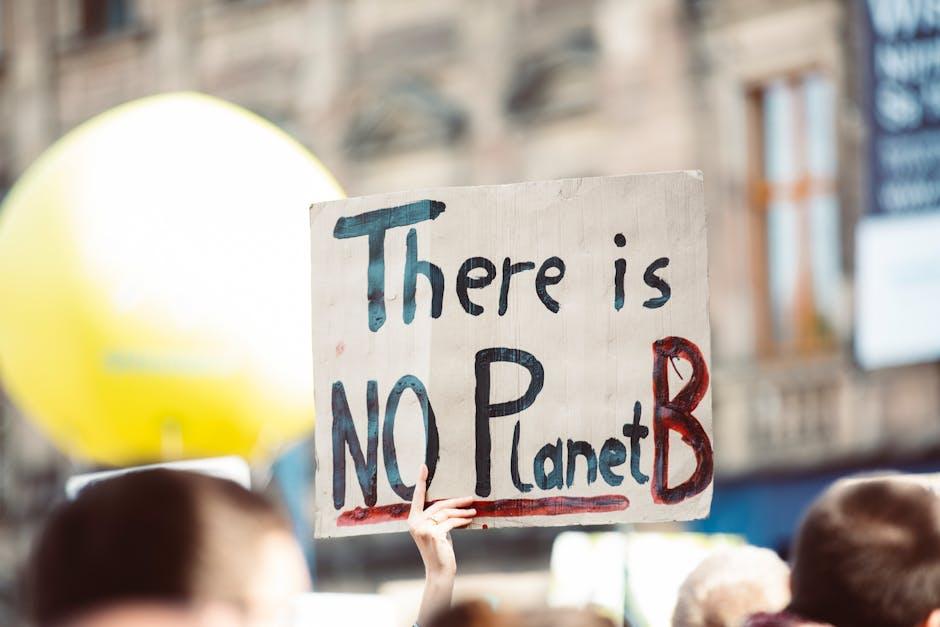Table of Contents
- Understanding James Lovelocks Vision for Earths Future
- Exploring the Concept of Gaia and Its Implications for Environmental Policy
- The Impact of Climate Change: Lovelock’s Warnings and Insights
- Practical Steps for Individuals and Communities to Foster Ecological Resilience
- Reimagining Our Relationship with Nature: Lessons from Lovelocks Legacy
- Q&A
- Concluding Remarks
Understanding James Lovelocks Vision for Earths Future
James Lovelock’s groundbreaking ideas revolve around the interconnectedness of life and the Earth as a self-regulating system. His concept of Gaia suggests that the planet functions like a living organism where every component, from the smallest bacteria to the vast oceans, plays a crucial role in maintaining balance. This interconnectedness allows Earth to regulate its environment in a way that supports life, and Lovelock emphasizes that understanding this balance is essential for ensuring a sustainable future. He warns that human activities disrupt these natural processes, leading to potential consequences that could threaten not just individual species but the entire biosphere.
Central to Lovelock’s vision is the notion that the Earth’s resilience is being tested due to climate change and environmental degradation. His predictions highlight various facets of this crisis, including:
- Resource depletion: Overconsumption and unsustainable practices are exhausting natural resources.
- Pollution: Chemical pollutants disrupt the delicate balance of ecosystems.
- Climate instability: Rising temperatures and extreme weather events escalate the challenges faced by all life forms.
In this context, Lovelock advocates a paradigm shift regarding our relationship with nature. He urges society to adopt a more conscious approach by recognizing our role as stewards of the Earth rather than its conquerors. This change requires a commitment to sustainable practices and policies that not only alleviate human impact but also restore and protect vital ecosystems.
To illustrate the urgency and scope of the changes needed, consider the following table that summarizes potential actions and their impacts:
| Action | Potential Impact |
|---|---|
| Adopting Renewable Energy | Reduces carbon footprint and promotes sustainable development. |
| Regenerative Agriculture | Enhances soil health and biodiversity, supporting crop resilience. |
| Conservation Efforts | Preserves habitats and protects endangered species. |
By embracing Lovelock’s vision, we not only acknowledge the intricacies of the Earth’s systems but also take proactive steps toward a harmonious existence within this remarkable living entity.

Exploring the Concept of Gaia and Its Implications for Environmental Policy
The concept of Gaia, proposed by James Lovelock, suggests that Earth functions as a self-regulating system, where living organisms interact with their inorganic surroundings to maintain conditions conducive to life. This interconnectedness has significant implications for environmental policy, as it highlights the need for a holistic approach to ecological management. Understanding Gaia encourages decision-makers to consider the interdependencies within ecosystems rather than treating species or habitats in isolation. Future policies must reflect this systemic thinking to create sustainable solutions.
One essential implication of the Gaia theory is the prioritization of biodiversity. A rich diversity of species contributes to the resilience of ecosystems, allowing them to adapt to changes and stresses, such as climate fluctuation and habitat destruction. Effective environmental policies should focus on protecting and enhancing biodiversity through various strategies, including:
- Creating protected areas to safeguard critical habitats.
- Implementing wildlife corridors to facilitate species migration.
- Promoting sustainable land-use practices that encourage habitat conservation.
Moreover, the Gaia theory prompts a reconsideration of how human activities impact the planet. For instance, policies should now emphasize reducing carbon footprints and regulating pollutants to mitigate climate change effects. As shown in the following table, implementing green technologies and practices can significantly reduce adverse impacts on the environment:
| Green Practice | Impact on Environment |
|---|---|
| Renewable Energy Adoption | Reduces greenhouse gas emissions |
| Sustainable Agriculture | Enhances soil health and biodiversity |
| Waste Reduction Programs | Minimizes landfill waste and pollution |
This transformative understanding of Earth as a living entity invites a shift in perspective on environmental governance. Policies rooted in Gaian principles advocate for long-term ecological sustainability rather than short-term economic gains, ultimately fostering a more harmonious coexistence between humanity and nature.

The Impact of Climate Change: Lovelock’s Warnings and Insights
James Lovelock, renowned scientist and environmentalist, has long been a prophetic voice regarding the future of our planet. His insights portray a vivid picture of the potential consequences of unchecked climate change, emphasizing that it is not merely an environmental challenge but a profound threat to human civilization. Lovelock’s work reiterates the complex interconnection between ecosystems and human activity, highlighting that the Earth operates as a self-regulating system. He introduces the idea of Gaia, where Earth functions as a single organism, integrating various life forms and climatic phenomena.
Central to Lovelock’s warnings is the inevitability of drastic changes if we fail to alter our current trajectory. His research conveys that rising temperatures could lead to severe consequences, such as
- Increased frequency of extreme weather events
- Destruction of essential ecosystems
- Mass extinction of species
- Threatened food and water security
Understanding these warning signs is critical in redirecting our approach to environmental stewardship. Lovelock’s insights urge us to recognize the urgency of adopting sustainable practices and fostering resilience in our communities. He challenges the conventional narrative of gradual change, advocating instead for immediate action to mitigate the effects of climate disruption.
As we dissect Lovelock’s contributions, one can draw parallels between his predictions and the data reflecting our current climate crisis. The following table encapsulates some of his key forecasts against current observations:
| Forecast | Current Observation | Implications |
|---|---|---|
| Increase in global temperatures | Average temp rise of 1.1°C (since pre-industrial era) | Melting glaciers, rising sea levels |
| Loss of biodiversity | Extinction rates accelerating | Imbalance in ecosystems, food supply issues |
| Increased natural disasters | Record-setting hurricanes and wildfires | Economic strain, loss of life and property |
The urgency in Lovelock’s conclusions serves as both a warning and a call to action. As global citizens, recognizing these correlations can empower us to advocate for meaningful change, leveraging Lovelock’s insights to inspire collaboration towards a more sustainable future. By understanding the consequences of climate change as outlined by Lovelock, we are better equipped to take proactive steps to preserve our planet for generations to come.

Practical Steps for Individuals and Communities to Foster Ecological Resilience
To foster ecological resilience, individuals can begin by adopting sustainable practices that minimize their environmental footprint. Simple actions such as reducing waste, conserving water, and opting for renewable energy sources contribute significantly to ecological health. Consider implementing the following strategies:
- Minimize single-use plastics: Opt for reusable bags, bottles, and containers.
- Support local ecosystems: Plant native species in gardens to promote biodiversity.
- Implement energy-saving measures: Use energy-efficient appliances and adopt habits like turning off lights when not in use.
Communities play an equally vital role in enhancing ecological resilience. By fostering collaboration and learning from each other’s experiences, communities can create impactful environmental initiatives. Key actions for community engagement might include:
| Action | Description |
|---|---|
| Community clean-ups | Organize regular events to clean local parks and waterways. |
| Support local farmers | Establish farmers’ markets to promote sustainable agriculture. |
| Workshops and education | Host events focusing on sustainability practices and ecological awareness. |
Embracing a mindset of resilience also involves promoting policies that support the environment. Individuals can advocate for greener policies at local and national levels, urging decision-makers to prioritize sustainable practices. Some actionable advocacy points include:
- Engaging in local governance: Participate in town hall meetings to voice environmental concerns.
- Building awareness: Use social media platforms to share information and raise awareness about ecological issues.
- Collaborating with NGOs: Partner with organizations focused on environmental conservation for more significant impact.

Reimagining Our Relationship with Nature: Lessons from Lovelocks Legacy
In the wake of James Lovelock’s profound insights, we find ourselves at a critical juncture in our relationship with the natural world. Lovelock, most famous for his Gaia theory, urged us to view Earth as a complex, self-regulating organism. This paradigm shift encourages us to rethink our roles within ecosystems, emphasizing interdependence rather than dominance. Recognizing that human well-being is inherently tied to ecological health can inspire a new sense of stewardship, compelling us to protect and preserve our planet for future generations.
Lovelock’s Legacy not only challenges us to act but also provides actionable lessons that can reshape our interaction with the environment. Key takeaways include:
- Respect for Biodiversity: Understanding that every species plays a vital role in maintaining ecological balance encourages conservation and sustainable practices.
- Holistic Thinking: Adopting a systems thinking perspective allows us to see the connections between human actions and environmental consequences, promoting more responsible decision-making.
- Urgency for Action: Lovelock calls for immediate interventions to combat climate change, highlighting renewable energy and reduced consumption as pathways to sustainability.
To illustrate these principles, consider the implications of Lovelock’s work on current environmental policies. Below is a simplified comparison of traditional and Gaia-inspired approaches:
| Traditional Approach | Gaia-Inspired Approach |
|---|---|
| Nature as Resource | Nature as Partner |
| Short-Term Solutions | Long-Term Sustainability |
| Exploitation of Ecosystems | Restoration and Care |
Q&A
Q&A: “James Lovelock and the Revenge of Gaia”
Q1: Who is James Lovelock, and why is he significant in environmental science?A1: James Lovelock is a renowned British scientist, environmentalist, and author, best known for his Gaia theory, which proposes that the Earth and its biological systems behave as a single, self-regulating entity. His work has challenged traditional views of the planet, emphasizing the interconnectedness of living organisms and their environment. Lovelock’s ideas have significantly influenced ecological science, helping to shape discussions around climate change and biodiversity.Q2: What does “La Venganza de la Tierra” mean, and how does it relate to Lovelock’s work?A2: “La Venganza de la Tierra,” which translates to “The Revenge of the Earth,” refers to the potential consequences of humanity’s impact on the planet. This term encapsulates Lovelock’s warnings about climate change and environmental degradation. He suggests that if humans continue to neglect their responsibilities towards nature, the Earth might retaliate through extreme weather, rising sea levels, and other catastrophic events. Essentially, it’s a call to recognize and respect the limits of our planet’s ecosystems.
Q3: What are the central themes of Lovelock’s writings in “La Venganza de la Tierra”?A3: Central themes in Lovelock’s writings include the urgency of addressing climate change, the ethical responsibilities humans have towards the environment, and the importance of adopting a holistic view of nature. He emphasizes that the health of the planet is intertwined with human existence, suggesting that our survival depends on understanding and cooperating with Earth’s natural systems rather than attempting to dominate them.
Q4: How has Lovelock’s Gaia theory influenced modern environmental movements?A4: Lovelock’s Gaia theory has inspired a wide range of environmental movements by promoting the idea that the Earth functions as a complex, self-regulating system. This perspective has encouraged activists and scientists to advocate for sustainability, conservation, and biodiversity. His theory has also influenced policies aimed at mitigating climate change, fostering a sense of stewardship rather than exploitation of natural resources.
Q5: What challenges and criticisms has Lovelock faced regarding his views?A5: Lovelock has faced various challenges and criticisms, particularly for his controversial views on technology and nuclear energy, which some argue contradict environmental sustainability. Critics often question the feasibility of his proposals and caution against determinism in his views of Earth’s self-regulation. Lovelock maintains that urgent responses to environmental crises are essential and that technology, when used wisely, can play a significant role in addressing ecological issues.
Q6: What can readers learn from Lovelock’s insights in “La Venganza de la Tierra”?A6: Readers can learn that the relationship between humanity and the Earth is complex and dynamic. Lovelock’s insights encourage a proactive approach to environmental stewardship, urging individuals and communities to recognize their role in ecological health. His work serves as a reminder of the dire consequences of inaction and the importance of embracing sustainable practices for the future of our planet.
This Q&A aims to uncover the essential aspects of James Lovelock’s thoughts and how they relate to contemporary environmental issues, providing a comprehensive understanding of “La Venganza de la Tierra.”



0 Comments